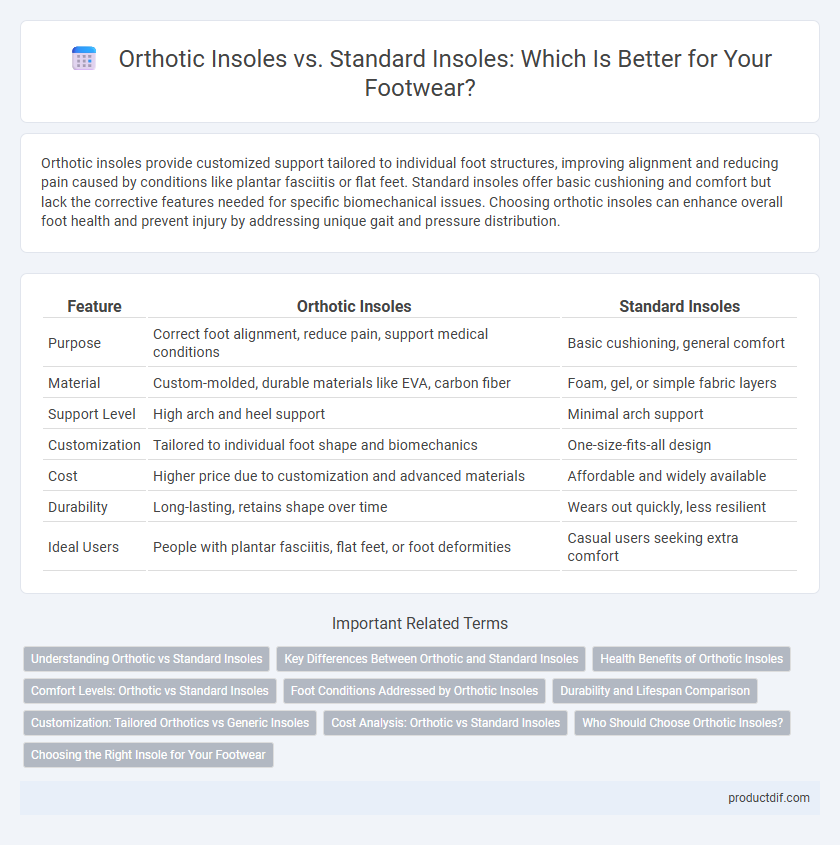Orthotic insoles provide customized support tailored to individual foot structures, improving alignment and reducing pain caused by conditions like plantar fasciitis or flat feet. Standard insoles offer basic cushioning and comfort but lack the corrective features needed for specific biomechanical issues. Choosing orthotic insoles can enhance overall foot health and prevent injury by addressing unique gait and pressure distribution.
Table of Comparison
| Feature | Orthotic Insoles | Standard Insoles |
|---|---|---|
| Purpose | Correct foot alignment, reduce pain, support medical conditions | Basic cushioning, general comfort |
| Material | Custom-molded, durable materials like EVA, carbon fiber | Foam, gel, or simple fabric layers |
| Support Level | High arch and heel support | Minimal arch support |
| Customization | Tailored to individual foot shape and biomechanics | One-size-fits-all design |
| Cost | Higher price due to customization and advanced materials | Affordable and widely available |
| Durability | Long-lasting, retains shape over time | Wears out quickly, less resilient |
| Ideal Users | People with plantar fasciitis, flat feet, or foot deformities | Casual users seeking extra comfort |
Understanding Orthotic vs Standard Insoles
Orthotic insoles provide customized arch support designed to correct foot alignment and alleviate specific biomechanical issues, whereas standard insoles primarily offer basic cushioning and shock absorption for general comfort. The materials in orthotic insoles, such as medical-grade EVA foam or carbon fiber, are precisely engineered to enhance stability and reduce pain caused by conditions like plantar fasciitis or flat feet. Standard insoles typically use generic foam or gel without targeted support, making them suitable for everyday wear but less effective for addressing foot deformities or chronic discomfort.
Key Differences Between Orthotic and Standard Insoles
Orthotic insoles are custom-designed to provide targeted support and correct biomechanical imbalances, while standard insoles primarily offer basic cushioning and comfort. Orthotic insoles enhance foot alignment and alleviate specific conditions such as plantar fasciitis, flat feet, or overpronation, unlike standard insoles which lack corrective features. Materials in orthotic insoles often include rigid or semi-rigid components for stability, whereas standard insoles typically use soft foam or gel for shock absorption.
Health Benefits of Orthotic Insoles
Orthotic insoles provide targeted arch support and correct foot alignment, reducing pain associated with plantar fasciitis, flat feet, and overpronation. They help distribute body weight more evenly, alleviating pressure on joints and preventing long-term musculoskeletal issues. Compared to standard insoles, orthotic insoles enhance overall foot function and contribute to improved posture and reduced risk of injury.
Comfort Levels: Orthotic vs Standard Insoles
Orthotic insoles provide superior comfort by offering customized arch support and pressure relief tailored to individual foot shapes, reducing pain and fatigue during prolonged wear. Standard insoles generally lack personalized support and cushioning, often leading to less effective shock absorption and increased discomfort over time. Users with specific foot conditions typically experience enhanced comfort and stability with orthotic insoles compared to generic standard options.
Foot Conditions Addressed by Orthotic Insoles
Orthotic insoles specifically target foot conditions such as plantar fasciitis, flat feet, and overpronation by providing customized arch support and cushioning that redistribute pressure more evenly across the foot. Unlike standard insoles, which mainly offer general comfort and basic shock absorption, orthotic insoles correct biomechanical imbalances to alleviate pain and improve foot function. These tailored supports also benefit individuals with arthritis, tendonitis, and diabetic foot ulcers by enhancing stability and reducing strain on sensitive areas.
Durability and Lifespan Comparison
Orthotic insoles typically offer superior durability compared to standard insoles due to their high-quality materials such as medical-grade foam, gel, or carbon fiber, designed to withstand prolonged use and maintain structural integrity. The lifespan of orthotic insoles can range from 12 to 18 months with regular wear, while standard insoles generally last only 3 to 6 months before flattening or losing cushioning support. Investing in orthotic insoles provides longer-lasting comfort and stability, making them cost-effective despite the higher initial price.
Customization: Tailored Orthotics vs Generic Insoles
Custom orthotic insoles are designed based on precise biomechanical assessments, providing individualized support that addresses specific foot conditions such as plantar fasciitis, pronation, or arch pain. In contrast, standard insoles offer generic cushioning without accommodating unique foot shapes or gait patterns, limiting their effectiveness for users with specialized needs. Tailored orthotics enhance comfort, improve alignment, and reduce injury risk by distributing pressure evenly according to the wearer's foot structure.
Cost Analysis: Orthotic vs Standard Insoles
Orthotic insoles typically cost between $100 and $300, reflecting their customized design to correct foot alignment, while standard insoles range from $10 to $50 and provide basic cushioning without correction. The higher upfront investment in orthotic insoles often results in long-term savings by reducing foot pain and preventing related musculoskeletal issues, potentially decreasing medical expenses and improving overall foot health. Standard insoles may require frequent replacements due to lower durability, increasing cumulative costs over time despite lower initial prices.
Who Should Choose Orthotic Insoles?
Individuals with chronic foot pain, flat feet, plantar fasciitis, or biomechanical issues benefit most from orthotic insoles, as they provide customized arch support and correct alignment. Athletes recovering from injury or those requiring enhanced shock absorption and stability also gain improved performance and reduced discomfort through orthotic use. People with diabetes or arthritis should consider orthotic insoles to alleviate pressure points and prevent complications related to foot health.
Choosing the Right Insole for Your Footwear
Orthotic insoles provide targeted arch support and corrective alignment, ideal for individuals with specific foot conditions such as plantar fasciitis or flat feet, enhancing comfort and reducing pain during extended wear. Standard insoles primarily offer basic cushioning and shock absorption, suitable for everyday casual use without specialized support needs. Selecting the right insole depends on foot health, activity level, and the type of footwear, ensuring optimal fit, stability, and long-term foot comfort.
Orthotic insoles vs Standard insoles Infographic

 productdif.com
productdif.com